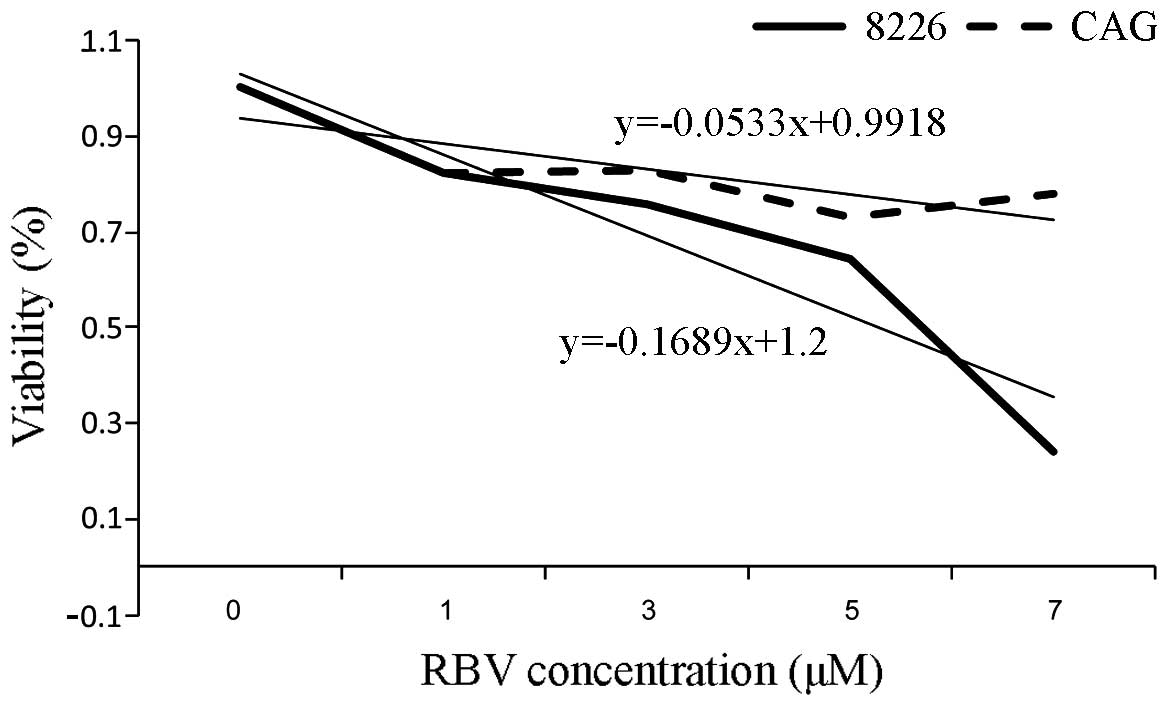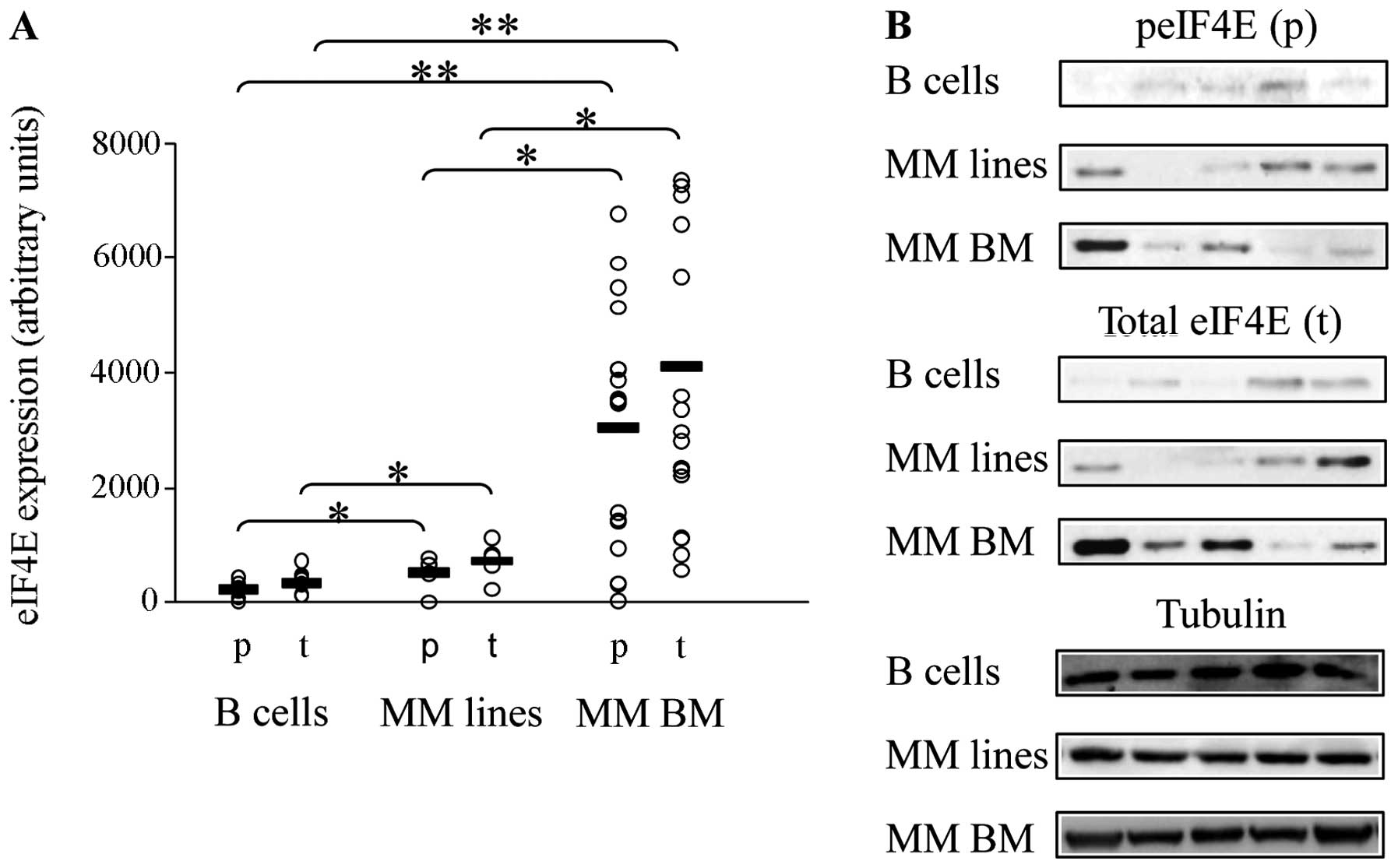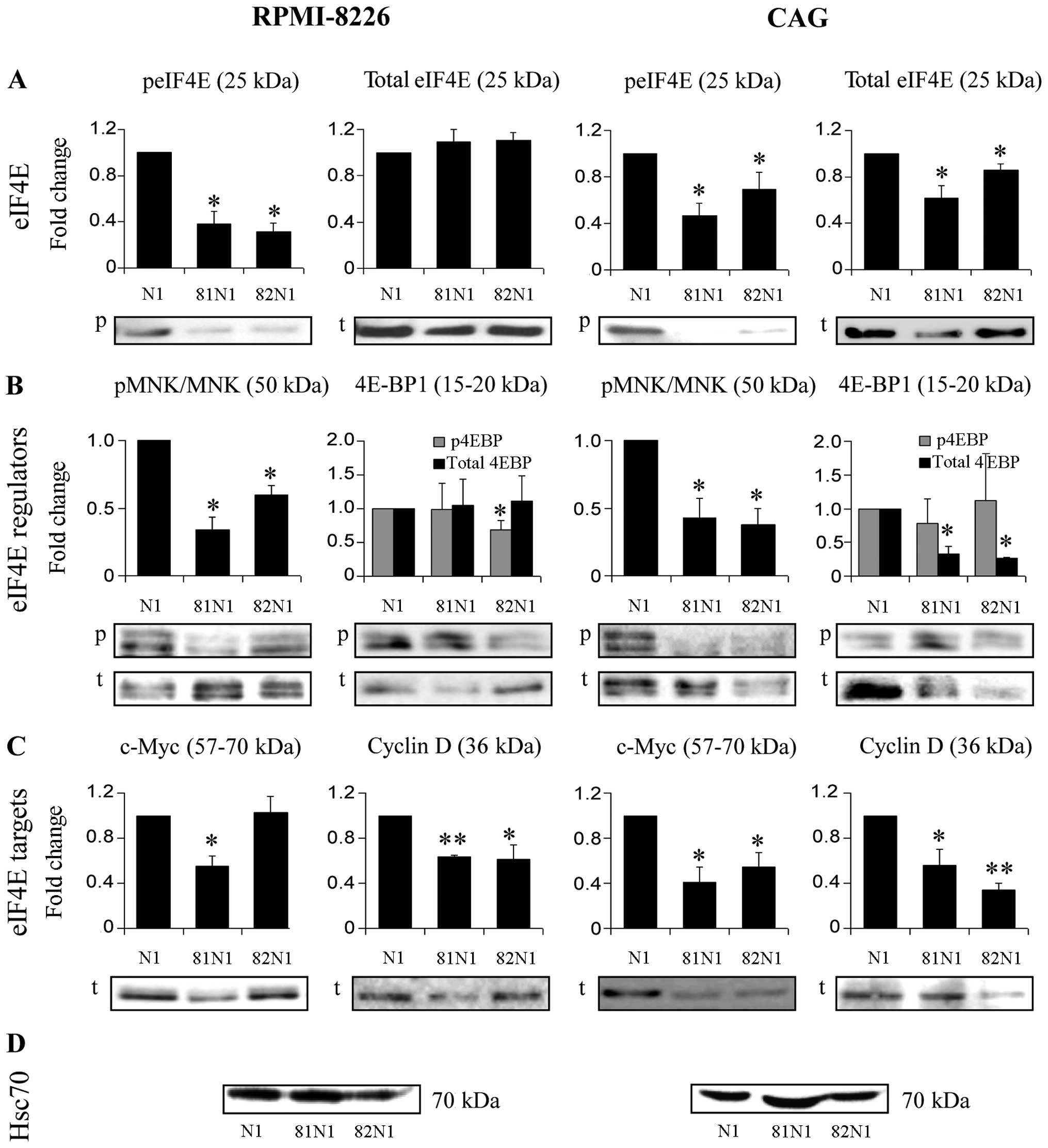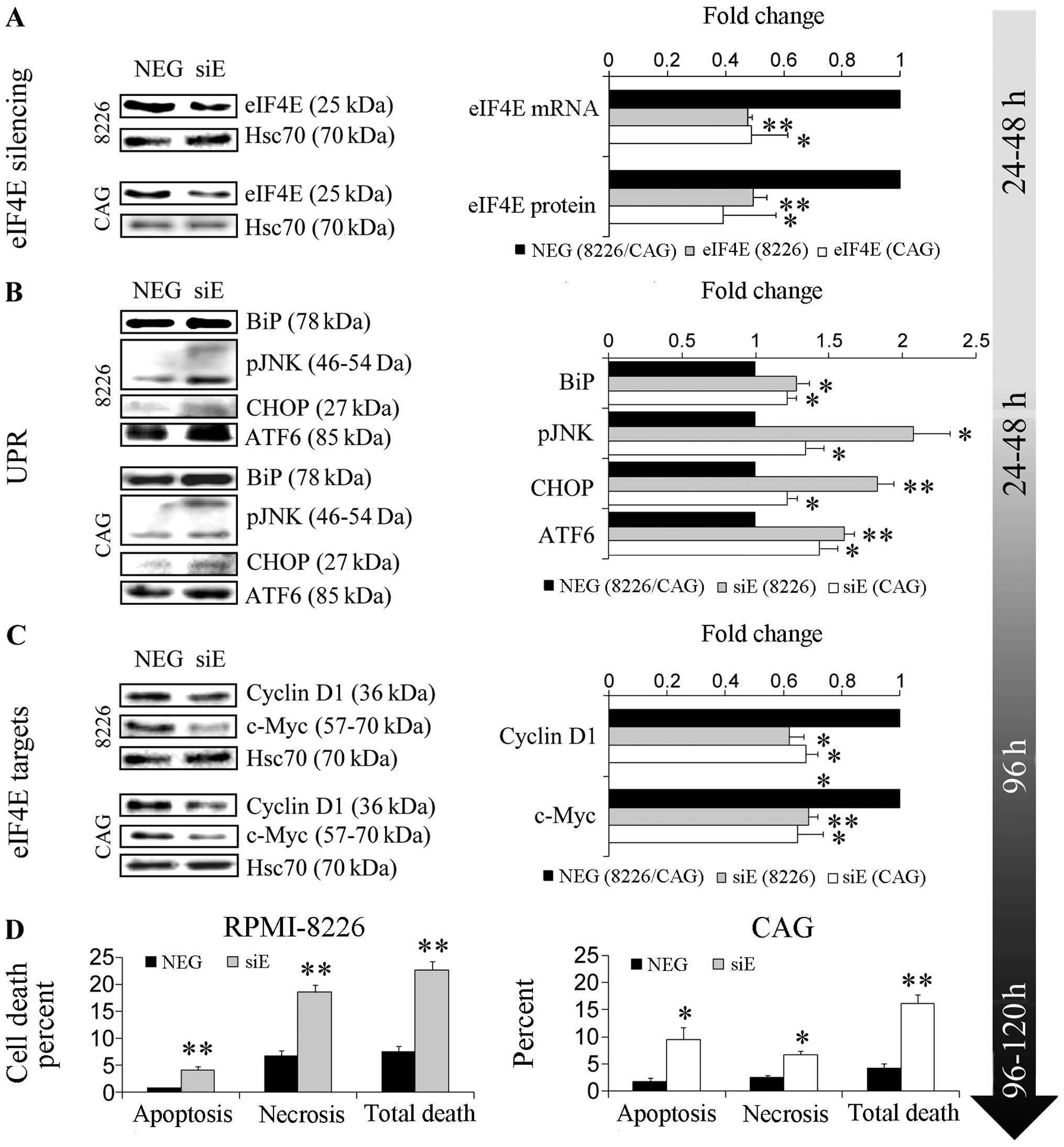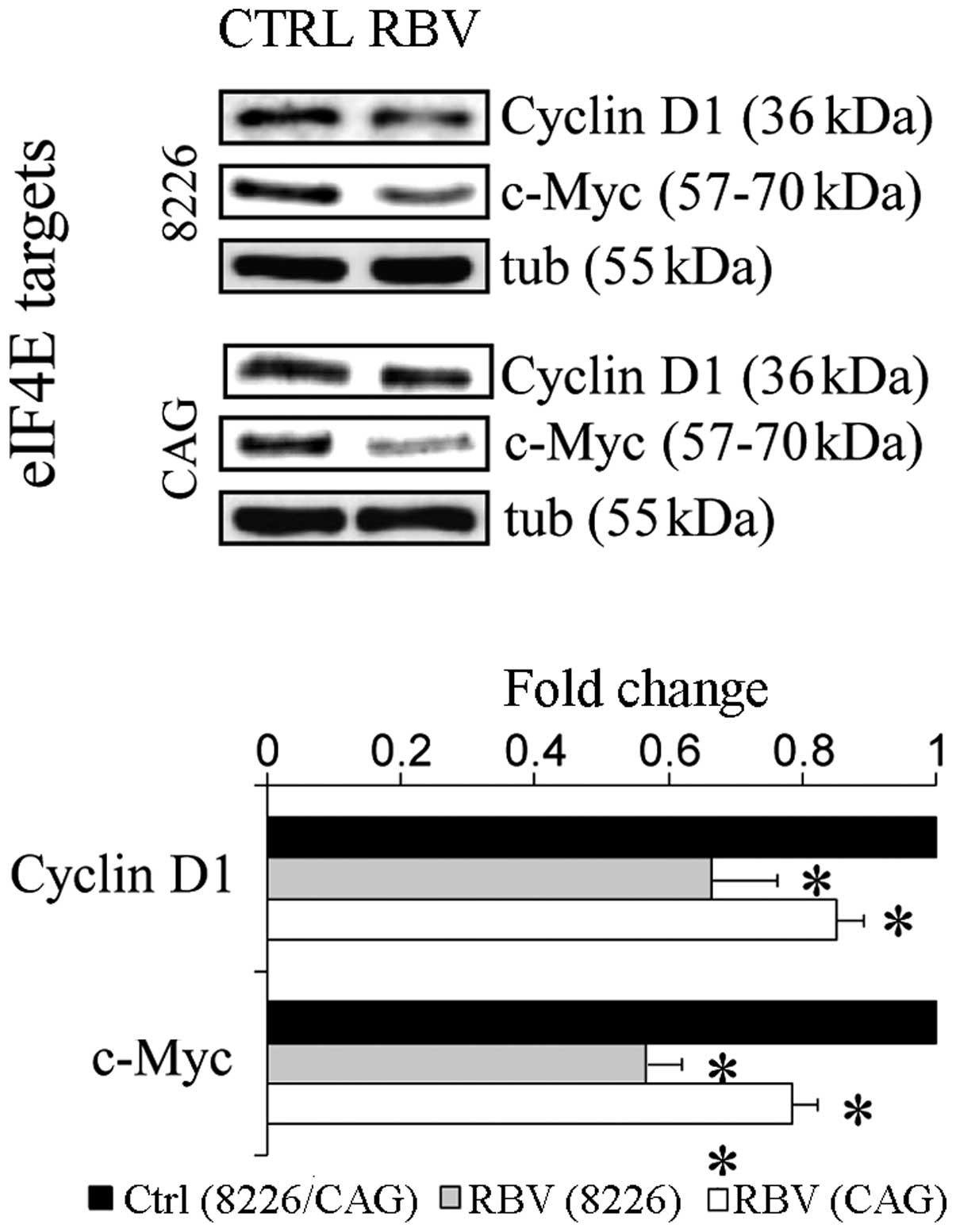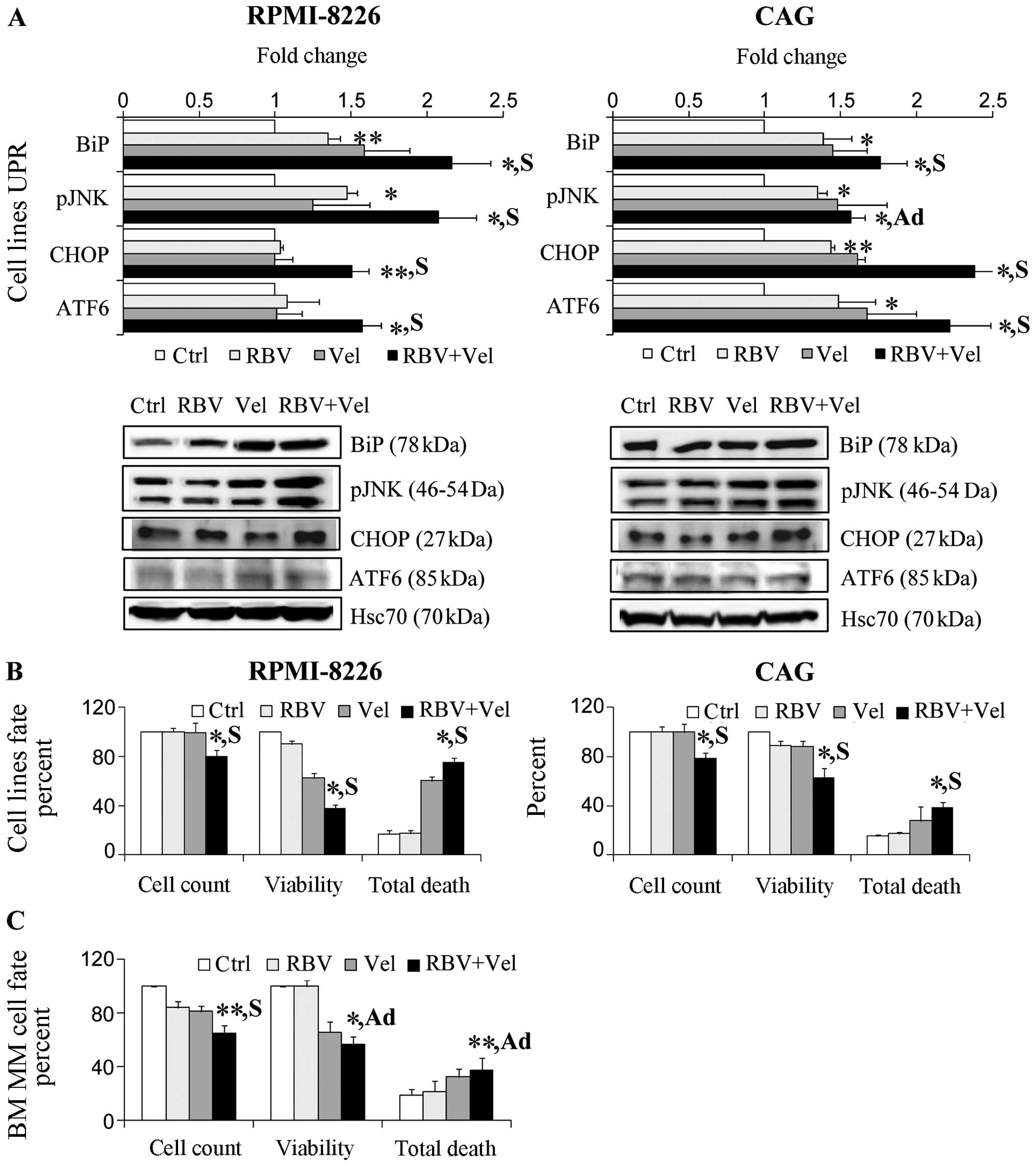|
1
|
Anderson KC: Targeted therapy of multiple
myeloma based upon tumor-microenvironmental interactions. Exp
Hematol. 35(Suppl 1): S155–S162. 2007. View Article : Google Scholar
|
|
2
|
Pratt G: Molecular aspects of multiple
myeloma. Mol Pathol. 55:273–283. 2002. View Article : Google Scholar : PubMed/NCBI
|
|
3
|
Agnelli L, Fabris S, Bicciato S, et al:
Upregulation of translational machinery and distinct genetic
subgroups characterise hyperdiploidy in multiple myeloma. Br J
Haematol. 136:565–573. 2007. View Article : Google Scholar : PubMed/NCBI
|
|
4
|
Barnhart BC and Simon MC: Taking aim at
translation for tumor therapy. J Clin Invest. 117:2385–2388. 2007.
View Article : Google Scholar : PubMed/NCBI
|
|
5
|
Cenci S and Sitia R: Managing and
exploiting stress in the antibody factory. FEBS Lett.
581:3652–3657. 2007. View Article : Google Scholar : PubMed/NCBI
|
|
6
|
Zismanov V, Lishner M, Tartakover-Matalon
S, Radnay J, Shapiro H and Drucker L: Tetraspanin-induced death of
myeloma cell lines is autophagic and involves increased UPR
signalling. Br J Cancer. 101:1402–1409. 2009. View Article : Google Scholar : PubMed/NCBI
|
|
7
|
Carrasco DR, Sukhdeo K, Protopopova M, et
al: The differentiation and stress response factor XBP-1 drives
multiple myeloma pathogenesis. Cancer Cell. 11:349–360. 2007.
View Article : Google Scholar : PubMed/NCBI
|
|
8
|
Patterson J, Palombella VJ, Fritz C and
Normant E: IPI-504, a novel and soluble HSP-90 inhibitor, blocks
the unfolded protein response in multiple myeloma cells. Cancer
Chemother Pharmacol. 61:923–932. 2008. View Article : Google Scholar
|
|
9
|
Larsson O, Li S, Issaenko OA, et al:
Eukaryotic translation initiation factor 4E induced progression of
primary human mammary epithelial cells along the cancer pathway is
associated with targeted translational deregulation of oncogenic
drivers and inhibitors. Cancer Res. 67:6814–6824. 2007. View Article : Google Scholar : PubMed/NCBI
|
|
10
|
Wang X and Proud CG: Methods for studying
signal-dependent regulation of translation factor activity. Methods
Enzymol. 431:113–142. 2007. View Article : Google Scholar : PubMed/NCBI
|
|
11
|
Montanaro L and Pandolfi PP: Initiation of
mRNA translation in oncogenesis: the role of eIF4E. Cell Cycle.
3:1387–1389. 2004. View Article : Google Scholar : PubMed/NCBI
|
|
12
|
Wu KD, Zhou L, Burtrum D, Ludwig DL and
Moore MA: Antibody targeting of the insulin-like growth factor I
receptor enhances the anti-tumor response of multiple myeloma to
chemotherapy through inhibition of tumor proliferation and
angiogenesis. Cancer Immunol Immunother. 56:343–357. 2007.
View Article : Google Scholar
|
|
13
|
Ramirez-Valle F, Braunstein S, Zavadil J,
Formenti SC and Schneider RJ: eIF4GI links nutrient sensing by mTOR
to cell proliferation and inhibition of autophagy. J Cell Biol.
181:293–307. 2008. View Article : Google Scholar : PubMed/NCBI
|
|
14
|
Kastrinakis NG, Gorgoulis VG, Foukas PG,
Dimopoulos MA and Kittas C: Molecular aspects of multiple myeloma.
Ann Oncol. 11:1217–1228. 2000. View Article : Google Scholar : PubMed/NCBI
|
|
15
|
Lin CJ, Cencic R, Mills JR, Robert F and
Pelletier J: c-Myc and eIF4F are components of a feedforward loop
that links transcription and translation. Cancer Res. 68:5326–5334.
2008. View Article : Google Scholar : PubMed/NCBI
|
|
16
|
Drucker L, Tohami T, Tartakover-Matalon S,
et al: Promoter hypermethylation of tetraspanin members contributes
to their silencing in myeloma cell lines. Carcinogenesis.
27:197–204. 2006. View Article : Google Scholar
|
|
17
|
Tohami T, Drucker L, Shapiro H, Radnay J
and Lishner M: Overexpression of tetraspanins affects multiple
myeloma cell survival and invasive potential. FASEB J. 21:691–699.
2007. View Article : Google Scholar : PubMed/NCBI
|
|
18
|
Lazo PA: Functional implications of
tetraspanin proteins in cancer biology. Cancer Sci. 98:1666–1677.
2007. View Article : Google Scholar : PubMed/NCBI
|
|
19
|
Charrin S, le Naour F, Silvie O, Milhiet
PE, Boucheix C and Rubinstein E: Lateral organization of membrane
proteins: tetraspanins spin their web. Biochem J. 420:133–154.
2009. View Article : Google Scholar : PubMed/NCBI
|
|
20
|
Zismanov V, Drucker L, Attar-Schneider O,
Matalon ST, Pasmanik-Chor M and Lishner M: Tetraspanins stimulate
protein synthesis in myeloma cell lines. J Cell Biochem.
113:2500–2510. 2012. View Article : Google Scholar : PubMed/NCBI
|
|
21
|
Lishner M, Zismanov V, Tohami T,
Tartakover-Matalon S, Elis A and Drucker L: Tetraspanins affect
myeloma cell fate via Akt signaling and FoxO activation. Cell
Signal. 20:2309–2316. 2008. View Article : Google Scholar : PubMed/NCBI
|
|
22
|
Su DF, Xu LP, Miao CY, Xie HH, Shen FM and
Jiang YY: Two useful methods for evaluating antihypertensive drugs
in conscious freely moving rats. Acta Pharmacol Sin. 25:148–151.
2004.PubMed/NCBI
|
|
23
|
Thiago LS, Perez-Andres M, Balanzategui A,
et al: Circulating clonotypic B cells in multiple myeloma and
monoclonal gammopathy of undetermined significance. Haematologica.
99:155–162. 2014. View Article : Google Scholar :
|
|
24
|
Assouline S, Culjkovic B, Cocolakis E, et
al: Molecular targeting of the oncogene eIF4E in acute myeloid
leukemia (AML): a proof-of-principle clinical trial with ribavirin.
Blood. 114:257–260. 2009. View Article : Google Scholar : PubMed/NCBI
|
|
25
|
Matassa DS, Amoroso MR, Agliarulo I, et
al: Translational control in the stress adaptive response of cancer
cells: a novel role for the heat shock protein TRAP1. Cell Death
Dis. 4:e8512013. View Article : Google Scholar : PubMed/NCBI
|
|
26
|
Issur M, Bougie I, Despins S and Bisaillon
M: Enzymatic synthesis of RNAs capped with nucleotide analogues
reveals the molecular basis for substrate selectivity of RNA
capping enzyme: impacts on RNA metabolism. PLoS One. 8:e753102013.
View Article : Google Scholar : PubMed/NCBI
|
|
27
|
Tan K, Culjkovic B, Amri A and Borden KL:
Ribavirin targets eIF4E dependent Akt survival signaling. Biochem
Biophys Res Commun. 375:341–345. 2008. View Article : Google Scholar : PubMed/NCBI
|
|
28
|
Mujtaba T and Dou QP: Advances in the
understanding of mechanisms and therapeutic use of bortezomib.
Discov Med. 12:471–480. 2011.PubMed/NCBI
|
|
29
|
Moriya S, Che XF, Komatsu S, et al:
Macrolide antibiotics block autophagy flux and sensitize to
bortezomib via endoplasmic reticulum stress-mediated CHOP induction
in myeloma cells. Int J Oncol. 42:1541–1550. 2013.PubMed/NCBI
|
|
30
|
Attar-Schneider O, Drucker L, Zismanov V,
Tartakover-Matalon S, Rashid G and Lishner M: Bevacizumab
attenuates major signaling cascades and eIF4E translation
initiation factor in multiple myeloma cells. Lab Invest.
92:178–190. 2012. View Article : Google Scholar
|
|
31
|
Graff JR and Zimmer SG: Translational
control and metastatic progression: enhanced activity of the mRNA
cap-binding protein eIF-4E selectively enhances translation of
metastasis-related mRNAs. Clin Exp Metastasis. 20:265–273. 2003.
View Article : Google Scholar : PubMed/NCBI
|
|
32
|
Culjkovic B, Topisirovic I, Skrabanek L,
Ruiz-Gutierrez M and Borden KL: eIF4E promotes nuclear export of
cyclin D1 mRNAs via an element in the 3′UTR. J Cell Biol.
169:245–256. 2005. View Article : Google Scholar : PubMed/NCBI
|
|
33
|
Wang X, Yue P, Chan CB, et al: Inhibition
of mammalian target of rapamycin induces phosphatidylinositol
3-kinase-dependent and Mnk-mediated eukaryotic translation
initiation factor 4E phosphorylation. Mol Cell Biol. 27:7405–7413.
2007. View Article : Google Scholar : PubMed/NCBI
|
|
34
|
Livingstone M, Larsson O, Sukarieh R,
Pelletier J and Sonenberg N: A chemical genetic screen for mTOR
pathway inhibitors based on 4E-BP-dependent nuclear accumulation of
eIF4E. Chem Biol. 16:1240–1249. 2009. View Article : Google Scholar
|
|
35
|
Rong L, Livingstone M, Sukarieh R, et al:
Control of eIF4E cellular localization by eIF4E-binding proteins,
4E-BPs. RNA. 14:1318–1327. 2008. View Article : Google Scholar : PubMed/NCBI
|
|
36
|
Saad H, Bellé R, Morales J, et al:
Initiation factors eIF4: from sea urchin embryonic development to
chronic lymphocytic leukemia. J Soc Biol. 201:307–315. 2007.(In
French). View Article : Google Scholar
|
|
37
|
Saito Y, Tachibana I, Takeda Y, et al:
Absence of CD9 enhances adhesion-dependent morphologic
differentiation, survival, and matrix metalloproteinase-2
production in small cell lung cancer cells. Cancer Res.
66:9557–9565. 2006. View Article : Google Scholar : PubMed/NCBI
|
|
38
|
Hasegawa M, Furuya M, Kasuya Y, et al:
CD151 dynamics in carcinoma-stroma interaction: integrin
expression, adhesion strength and proteolytic activity. Lab Invest.
87:882–892. 2007. View Article : Google Scholar : PubMed/NCBI
|
|
39
|
Maecker HT: Human CD81 directly enhances
Th1 and Th2 cell activation, but preferentially induces
proliferation of Th2 cells upon long-term stimulation. BMC Immunol.
4:12003. View Article : Google Scholar : PubMed/NCBI
|
|
40
|
Zöller M: Tetraspanins: push and pull in
suppressing and promoting metastasis. Nat Rev Cancer. 9:40–55.
2009. View Article : Google Scholar
|
|
41
|
Jee BK, Park KM, Surendran S, et al:
KAI1/CD82 suppresses tumor invasion by MMP9 inactivation via TIMP1
up-regulation in the H1299 human lung carcinoma cell line. Biochem
Biophys Res Commun. 342:655–661. 2006. View Article : Google Scholar : PubMed/NCBI
|
|
42
|
Suzuki M, Tachibana I, Takeda Y, et al:
Tetraspanin CD9 negatively regulates lipopolysaccharide-induced
macrophage activation and lung inflammation. J Immunol.
182:6485–6493. 2009. View Article : Google Scholar : PubMed/NCBI
|
|
43
|
Dua K, Williams TM and Beretta L:
Translational control of the proteome: relevance to cancer.
Proteomics. 1:1191–1199. 2001. View Article : Google Scholar : PubMed/NCBI
|
|
44
|
Jain MK and Zoellner C: Role of ribavirin
in HCV treatment response: now and in the future. Expert Opin
Pharmacother. 11:673–683. 2010. View Article : Google Scholar : PubMed/NCBI
|
|
45
|
Culjkovic B and Borden KL: Understanding
and targeting the eukaryotic translation initiation factor eIF4E in
head and neck cancer. J Oncol. 2009:9816792009. View Article : Google Scholar
|
|
46
|
Tamburini J, Green AS, Chapuis N, et al:
Targeting translation in acute myeloid leukemia: a new paradigm for
therapy? Cell Cycle. 8:3893–3899. 2009. View Article : Google Scholar : PubMed/NCBI
|
|
47
|
Panfilio S, D’Urso P, Annechini G, et al:
Regression of a case of Multiple Myeloma with antiviral treatment
in a patient with chronic HCV infection. Leuk Res Rep. 2:39–40.
2013.PubMed/NCBI
|



